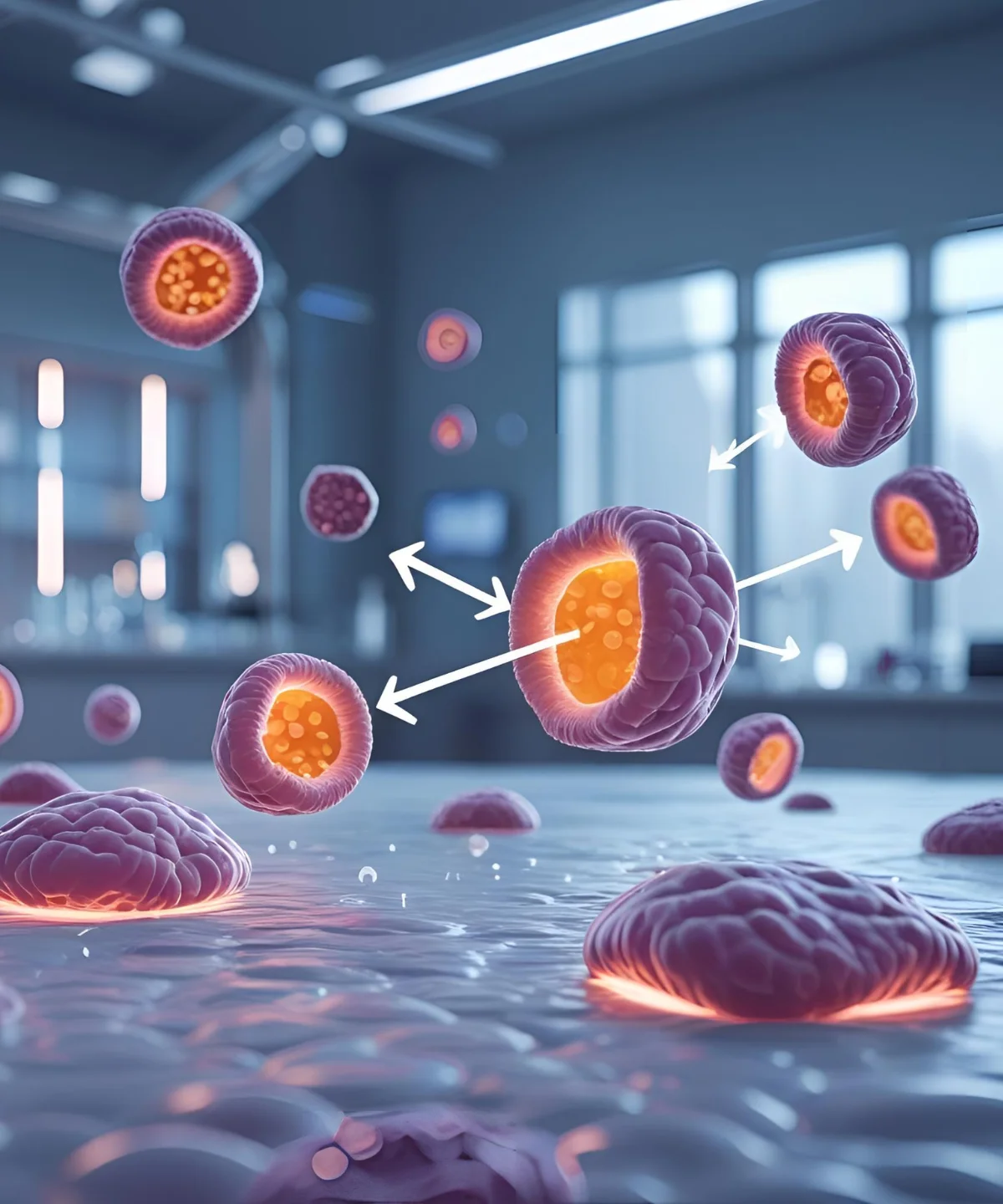Mesenchymal Stem Cell Exosomes: The Future of Cell-Free Regenerative Therapy
Mesenchymal stem cell exosomes are emerging as a groundbreaking alternative to traditional stem cell therapy, offering powerful healing and anti-inflammatory effects without using live cells. Derived from the secretome of MSCs, these nano-sized extracellular vesicles carry vital proteins, RNAs, and signaling molecules that promote tissue repair, immune modulation, and cell-to-cell communication. As a cell-free regenerative medicine approach, MSC-derived exosomes are safer, more scalable, and easier to standardize than full-cell transplants. From neurological repair to skin rejuvenation, their applications are rapidly expanding in both clinical and aesthetic fields.

What Are Mesenchymal Stem Cell Exosomes?
Mesenchymal stem cell exosomes are nanosized extracellular vesicles released by MSCs as part of their secretome—a collection of bioactive molecules that mediate healing through paracrine signaling. Unlike full stem cells, exosomes do not replicate or engraft but instead deliver therapeutic effects by transferring their cargo—including microRNAs, proteins, lipids, and growth factors—to target cells. These vesicles typically range from 30–150 nanometers and are identified by surface markers such as CD63, CD9, CD81, and TSG101. Their ability to mimic the regenerative and immunomodulatory properties of MSCs—without the risks associated with live-cell therapies—makes them a key focus in NIH-backed research and a promising candidate in cell-free regenerative medicine.
How MSC Exosomes Work in the Body
MSC exosomes play a vital role in cell-to-cell communication, acting as messengers that regulate the body’s natural repair systems without the need for live stem cell transplantation. Through the targeted delivery of microRNAs, proteins, and lipids, these vesicles influence nearby and distant cells, modifying their behavior to promote healing and reduce inflammation.
Key anti-inflammatory molecules found in MSC exosomes include IL-10, TGF-β, and VEGF, which help control immune responses, reduce tissue damage, and promote angiogenesis—the formation of new blood vessels. This enhances tissue repair and helps restore immune balance in damaged or diseased tissues.
Unlike full mesenchymal stem cells, exosomes do not engraft or replicate. Instead, they function through a paracrine signaling mechanism, making them a safer and more targeted cell-free therapy option. This exosome-mediated repair model allows for precise, non-invasive delivery of therapeutic signals, reducing many of the risks associated with traditional stem cell interventions.
Benefits of MSC-Derived Exosomes Over Traditional Stem Cell Therapy
Mesenchymal stem cell exosomes offer a safer, more practical alternative to live stem cell treatments. Their cell-free nature reduces risks and simplifies storage, delivery, and clinical use.
A Safer Alternative Without Tumor Risk or Rejection
MSC-derived exosomes provide the regenerative benefits of stem cells without the risks associated with live-cell therapy. Since exosomes do not replicate or contain nuclear DNA, there is no risk of tumor formation or inappropriate differentiation. Their acellular nature also reduces the chances of immune rejection, making them safer for allogeneic (donor-based) use.
Standardized Dosing and Scalable Manufacturing
Unlike live stem cells, which can vary in potency and behavior, exosomes allow for standardized dosing, ensuring consistent therapeutic outcomes. When produced under GMP-certified conditions, exosome batches can be quality-controlled and replicated at scale, a major step toward regulatory approval and clinical mainstreaming.
Improved Stability and Longer Shelf Life
Exosomes are more stable than stem cells, with the ability to withstand cryopreservation and, in some cases, storage at room temperature in lyophilized (freeze-dried) form. This extended shelf life makes them easier to manage in clinical settings and simplifies logistics for international distribution.
Simplified Administration and Delivery Options
Due to their small size and cell-free nature, MSC exosomes are easier to ship, store, and administer. They can be delivered via injections, topical gels, or even eye drops, without the need for surgical procedures or complex cell handling. This flexibility broadens their use across dermatology, neurology, orthopedics, and more.
Clinical Applications of MSC Exosomes
MSC exosome therapy is being explored across a wide range of conditions due to its regenerative, anti-inflammatory, and immunomodulatory properties. These exosome-based treatments are especially promising in areas where traditional therapies fall short.
Neurological Diseases: Parkinson’s, Alzheimer’s, and Spinal Cord Injury
MSC exosomes show neuroprotective effects by reducing inflammation, delivering neurotrophic factors, and promoting neuron survival. Research into conditions like Parkinson’s disease, Alzheimer’s, and spinal cord injury suggests that exosome therapy may aid neural repair and slow disease progression.
Autoimmune Conditions: Lupus and Rheumatoid Arthritis
Due to their strong immunomodulatory abilities, regenerative exosomes are being tested for autoimmune diseases like lupus and rheumatoid arthritis. They help regulate immune responses, suppress overactive immune cells, and reduce chronic inflammation without suppressing overall immunity.
Wound Healing and Skin Repair
MSC exosomes accelerate wound healing, promote collagen production, and reduce scarring. They are effective in treating chronic wounds, burns, and skin ulcers by enhancing tissue regeneration and modulating local inflammation.
Lung Disease and COVID-19/ARDS Recovery
During the COVID-19 pandemic, exosomes gained attention for their role in lung repair. Trials listed on ClinicalTrials.gov explore their use in COVID-19 and acute respiratory distress syndrome (ARDS), where they help regulate cytokine storms and reduce lung tissue damage.
Aesthetic Use: Anti-Aging, Hair Regrowth, and Scar Reduction
In aesthetic medicine, companies like ExoCoBio have developed exosome-based skincare and injectable products. These promote skin rejuvenation, hair regrowth, and scar fading by stimulating collagen, reducing inflammation, and supporting tissue renewal.
Current Research and Clinical Trials
Exosome clinical trials are gaining momentum worldwide as researchers investigate their role in safe, effective, and scalable regenerative therapies. Backed by major institutions, early findings are promising.
Ongoing Clinical Trials Listed on ClinicalTrials.gov
Dozens of exosome-based trials are registered on ClinicalTrials.gov, exploring applications in orthopedic recovery, neurodegeneration, autoimmune disorders, and post-COVID-19 lung injury. These studies evaluate dosing, delivery methods, and treatment outcomes.
Institutional Support and Biotech Involvement
Organizations like the NIH, Capricor Therapeutics, and Lonza are leading efforts to develop standardized, GMP-compliant exosome platforms. Their research helps bridge the gap between lab science and clinical use, with several therapies already in early human trials.

Early-Phase Data on Safety and Efficacy
Initial studies show strong safety profiles and potential efficacy in reducing inflammation, promoting healing, and modulating immune responses. While long-term outcomes are still under investigation, early-phase trials report minimal adverse effects and positive biological responses.
Regulatory Status and FDA Oversight
In the U.S., exosome products are regulated by the FDA as biological agents under investigational use. Most current treatments are part of early-stage clinical research and have not yet received full approval. GMP compliance and standardized protocols remain critical for future regulatory clearance.
Challenges and Considerations
Despite their potential, MSC-derived exosomes face several scientific, manufacturing, and regulatory hurdles. Addressing these challenges is essential for clinical translation and global adoption.
Difficulties in Exosome Isolation and Purification
One of the biggest technical barriers is achieving consistent and pure exosome isolation. Techniques like ultracentrifugation, size exclusion chromatography, and filtration each have limitations, affecting yield and quality. Ensuring reproducible results across labs remains a key issue in exosome-based therapy development.
Lack of Standardization in Production
There is currently no universal protocol for MSC product standardization, leading to variability between manufacturers. Differences in MSC source, culture conditions, and isolation methods result in inconsistent therapeutic effects, making it harder to validate outcomes in clinical trials.
Need for GMP-Certified Manufacturing
Producing GMP-grade exosomes is essential for regulatory approval and clinical safety. Biotech companies like Kimera Labs and RoosterBio are working toward scalable, compliant manufacturing processes. However, high costs and technical complexity continue to slow widespread adoption.
Regulatory Differences Between Countries
Global regulation of exosome therapies varies. While the FDA and EMA treat exosomes as biologics requiring strict oversight, some countries allow more lenient use. Harmonizing guidelines and aligning with ISO standards is necessary to ensure safety, consistency, and ethical practices worldwide.
The Future of Exosome-Based Therapy
MSC exosomes are not just a promising therapy—they are the foundation for the next wave of personalized regenerative medicine. Innovations in AI, biomaterials, and gene editing are shaping a smarter, more targeted future.
AI-Driven Exosome Profiling and Targeting
Artificial intelligence (AI) is playing a growing role in analyzing exosome profiles to predict therapeutic responses and optimize targeting. Machine learning models can identify specific RNA or protein cargo signatures, helping tailor exosome-based treatments to individual patients.
